|
Next on the list of big launch events is coming out of LG on April 28 in New York, London, and Paris simultaneously (with an event in Seoul, Singapore the following day, on April 29). There are no guarantees of course, but we have our fingers crossed that it means there will be a new version of their flagship smartphone coming from the South Korean company, the much-anticipated LG G4 (which seems even more likely when you take a close look at the enlarged G’s on the invitation, pictured above). (If we take the design of the invitation literally, it may also mean that a leather-backed body should also be expected…) Those loving rumours and speculation will be happy to know that benchmark results have been spotted around the Internet suggesting the LG G4 will run Android 5.1 Lollipop, be powered by a hexa-core 64-bit Snapdragon 808 processor, sport a 5.5-inch QHD display (boasting 1440×2560 pixels), have 3GB of RAM, feature 32GB of on-board storage, and take photos with an 8-megapixel front camera. The exterior design is still somewhat of a mystery, though the expectations are that the phone will be ‘radically different’ than their current LG G3 flagship smartphone. If LG wants to compete with the big guys out there already (thinking most specifically about the recently launched Samsung Galaxy S6), there had better be a secondary announcement of a phablet-sized version of the G4 –but there is no word yet on how likely that is. Are any of you looking forward to seeing what LG has to offer? What would persuade you to choose LG over other phones from the reigning Android heavyweights (beyond Samsung’s Galaxy S6, the HTC One M9 has serious competitive potential)?
LG Wants You to Save the Date for April 28 Product Launch is a post from: Good e-Reader |
A Semi-automated Technology Roundup Provided by Linebaugh Public Library IT Staff | techblog.linebaugh.org
Monday, March 30, 2015
LG Wants You to Save the Date for April 28 Product Launch
Surge Your Adrenaline Playing Fast & Furious: Legacy for Android
|
The promise of a solid race-themed game has been known to motivate the purchase of entire console gaming systems –so the release of a quality title for mobile should be heard as very good news by fans of the genre. Fast & Furious: Legacy covers all seven titles in the film franchise, providing a true journey through the street racing experience. There aren’t many surprises with this game, but that shouldn’t be seen as a bad thing. In a world that is all about the hottest car models and the thrill of speeding, just being able to participate using a mobile device (in stunning HD) is exciting! Start with the basics, and spend time customizing your ride (with ‘the hottest paint, vinyls, rims, and more’), unlock extras (like nitrous upgrades), and explore locations based on the movies (from Los Angeles to Miami and beyond); the more you play, the more sophisticated things will become. Run your own crew, battle against others, and find your way to the top of the leaderboards. You can grab Fast & Furious Legacy for free now for your Android device (but have no fear, you will have plenty of opportunities to spend money in-app with this game).
Surge Your Adrenaline Playing Fast & Furious: Legacy for Android is a post from: Good e-Reader |
Onyx Boox i86 HD e-Reader Review
| The e-reader industry is dominated by six inch devices chiefly because of the portability and cost effectiveness. Large screens tend to be very niche and carry a huge price tag. Onyx is hoping to buck this trend with the advent of the i86 HD e-reader which has an 8 inch screen and costs $325.00. Hardware The Onyx i86 HD features an eight inch IR touchscreen with a resolution of 1600 x 1200 with 250 PPI. It does not have a front light like most contemporary e-readers which helps keep the cost down. This particular e-reader model is not using a super modern version of e-paper, as found on the Kindle Voyage or Kobo H2o, instead it is employing an older form of Pearl. Normally, I would lament the screen quality is poor, but this couldn’t be further from the truth. In reality, reading e-books, manga and PDF files is amazing. Onyx has a bunch of software functions that enhance the rendering of image heavy content. Underneath the hood is a 1 GHZ single core processor, 512 MB of RAM and 4 GB of internal storage. There is compatibility for an Micro SD, so you can easily enhance it further up to 32 GB. One of the most exciting features about this reader is the fact it has Bluetooth and a 3.5mm headphone jack. This allows for the playbook of audiobooks and music. In addition, you can hook up external speakers to get a ton of streaming content from companies such as Spotify or Soundcloud. Software The Onyx Boox i86 is running Google Android 4.04 as the primary operating system. It comes bundled with Google Play, which gives customers the ability to download their own e-reading apps, without limitations. When you take this e-reader out of the box for the first time there isn’t very much content on it. There is two e-reading apps and Google Play, and that’s it. There is no library of royalty free e-books to get you started right away, which is a good thing. Many e-readers these days are shipped with a few hundred books on them and are normally instantly deleted to make room for paid content. When you take the i86 out of the box for the first time there is no digital bookstore bundled on it to start buying e-books, digital magazines, manga, newspapers or audiobooks right away. You will want to employ Google Play with your existing or new account to download your favorite apps. It is important to note that despite it can run Android apps, it will not play many games. In addition, anything with complex animations will also not give you a good experience. I would recommend Kobo, Nook, Manga Meow, Replico Reader, Adobe PDF Reader as apps that are fully compatible with the i86. Wrap up The Onyx i86 HD is not officially released yet and the version we reviewed was the final production model. It is currently available only via EBAY and costs $325.00 US. I think this e-reader is perfect for people who need a larger screen to read and felt underwhelmed by the Cybook Ocean. I like the fact it has audio capabilities and allows users to install their own apps via Google Play. PROS 8 Inches CONS Dictionary Support is non-existent Rating: 8/10 Onyx Boox i86 HD e-Reader Review is a post from: Good e-Reader |
URL: http://goodereader.com/blog/electronic-readers/onyx-boox-i86-hd-e-reader-review
The Young Innovators’ Club in Ulaanbaatar
| The Young Innovators’ Club is a new initiative to promote engineering and tech education for school-aged children in Mongolia. It’s currently piloting a Raspberry Pi-based after-school club in Mongolia’s capital, Ulaanbaatar, with support from the National Information Technology Park, where activities take place: 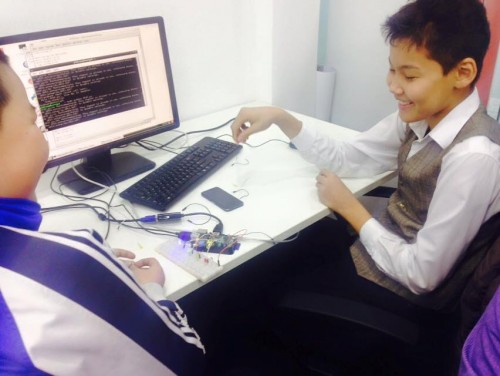  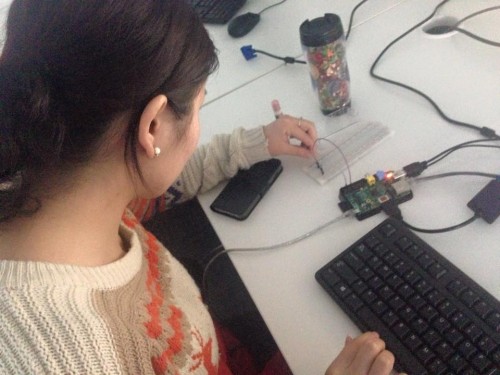 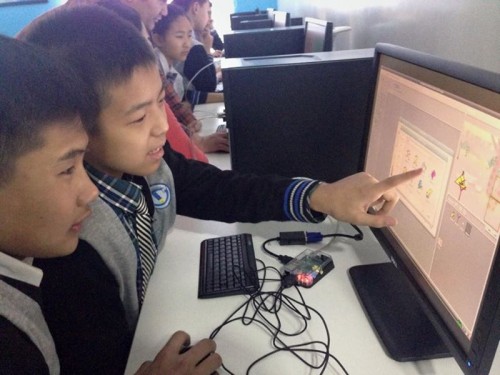 Scratch and Python are on the menu, and electronics features prominently, with students using Raspberry Pis to control LEDs, sensors, motors and cameras. Club Coordinator Tseren-Onolt Ishdorj says,
The idea of introducing Raspberry Pi-based after-school clubs was originally that of Enkhbold Zandaakhuu, Chairman of the Mongolian Parliament and himself an engineer by training; a group of interested individuals picked up the idea and established the Club in late 2014, and it has since attracted the interest of peak-time Mongolian TV news and other local media. The Club plans to establish After-School Clubs for Inventors and Innovators (ASCII) across the country with the help of schools, parents and other organisations and individuals; this would involve about 600-700 schools, and include training for over 600 teachers. They’re hopeful of opening a couple of dozen of these this year. We’re quite excited about this at Raspberry Pi. It was lovely to see our Raspberry Jams map recently showing upcoming events on every continent except for Antarctica (where there are Pis, even if not, as far as we know, any Jams), but nonetheless there’s a displeasing Pi gap across central Asia and Russia: 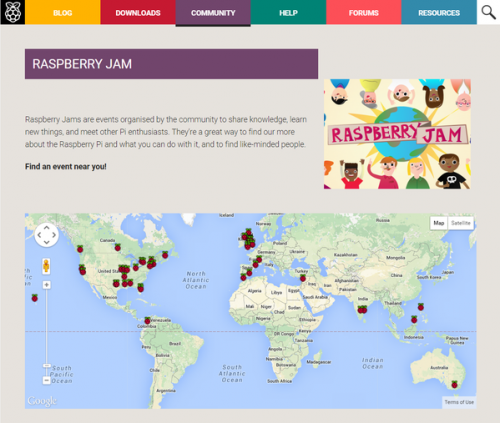 Raspberry Jams on every continent except Antarctica (yes, really: the one that seems to be on the south coast of Spain is actually in Morocco) It’s fantastic to know, then, that school students are learning with Raspberry Pis in Ulaanbaatar. We’ll be keeping up with developments at the Young Innovators’ Club on their Facebook page, where you can find lots of great photos and videos of the students’ work – we hope you’ll take a look, too. 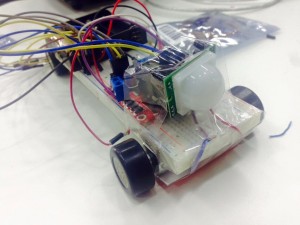 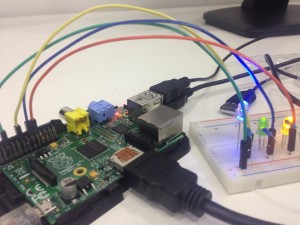 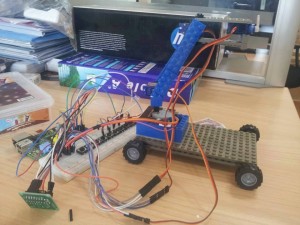 |
A chat with Big Library Read author Dr. Laura Bates
| Last week I had the chance to chat with Dr. Laura Bates, author of the Big Library Read title Shakespeare saved my life, via Twitter. Dr. Bates took some time out of her Friday to answer questions curated from readers from around the world. Below are some of the questions and answers. You can view the Twitter chat here and check out some of her extended answers to questions below!  Tell us your first memory of going to a library Starting around age 5, I would walk 2 miles to the public library with my older sister, in hot summers and snowy winters…checking out as many books as I could carry (often MORE than I could carry). My interests were eclectic: travel, nature, literature. I was a "regular" in my elementary school library, as well. That's where I checked out "Macbeth" at the age of 10. Of course, I couldn't understand it; it was a foreign language to me, but looking back, I can see what a life-changing moment that was for me! My parents, although they were immigrants, were book-lovers, and I inherited that trait. If the roll was reversed would you feel comfortable w/ a significant other doing the work you do? What has been your most rewarding moment of this program? What is your favorite Shakespeare piece? What message do you hope readers take away of this book? Adam Sockel is a Social Media Specialist with OverDrive. He now has a new appreciation for the Bard. |
URL: http://feedproxy.google.com/~r/OverdrivesDigitalLibraryBlog/~3/_3VfUpUEyTA/
Clean Reader Controversy: Censorship, or Right to Read?
|
One of the recent controversies in publishing involves the creation of an app called Clean Reader that has authors of every level crying censorship. Built by two parents who claim their daughter was upset by the amount and level of profanity in a book she was reading, the app takes an ebook and “filters” out the naughty words with three levels for the reader to choose from. Readers can decide that “damn” is okay but not “f***,” for example, all the way up to the strictest setting that will filter out biological terms for human genitalia. Personal feelings on sheltering one’s children aside, it’s important to understand how this is not censorship. First, nothing about the original manuscript is actually changed. The author’s original work is still available for sale elsewhere; this would almost be akin to an app selling a translated version of the book, since the author himself cannot speak or write in Swahili and someone else decided what words would appear in the file. Second, by definition censorship requires a larger-scale effort than one reader choosing to read a version of the book with the profanity removed. If the government required the profanity to be removed in order for the book even to be published, that would be censorship. The debate on both sides has been very interesting. Supporters of the app have stated that this is simply allowing choice for the readers, and that audiences who would have avoided the author’s work entirely for its word choices can now support the author and take part in the dialogue about the book. Other supporters have pointed out that this was a parent-driven effort, and that we should applaud these parents for not taking the typical route of complaining to the school and having the book pulled from the shelves. They didn’t interfere with other children’s enjoyment of the book, they simply provided an avenue (at their own expense) for their daughter to read roughly the same books as her peers–with their same tones, plots, and themes–without having to wade through words that the child herself found objectionable. Where things got tricky was in the selling of the books through Clean Reader. Basically, the app isn’t capable of taking any document in any file format and simply replacing certain words. The book has to get the “cleaning” treatment and then be available for sale. While supporters can easily take the stance that authors should be grateful for any sale they get, this did irk a number of authors, and for good reason. It’s one thing to filter a book at the reader’s discretion, as that would be like flipping past the sex scenes in an erotica title to get to the story. It’s something else altogether when a bookstore owner rips out the pages that contain “smut” and then sells the book on her shelves with the claim that it is “clean.” The saddest issue in this controversy is the argument that profanity in published books is a fact and that readers should have to simply put up with it because that’s how the author wrote it; the point was even made that the couple who developed the app are “sheltering” their daughter from the real world by not letting her read books with bad words in them. Critics of this app have basically said the authors’ craft is more important than the readers’ sensibilities. This would be far more understandable a concern if most consumers knew how much an author’s work is stripped away in the editorial process by major publishers, and then understood that self-published authors often chose to pursue indie authorship because random gatekeepers had deemed their book wasn’t fit or worthy enough for mass market publication. Telling an author that there’s now one more level of censor before the book can be read can sting. Unfortunately, there’s a middle ground that could be reached, and neither side has looked for it. The answer may not be simple, of course, but nothing like this ever is. This app could have been incredibly helpful for teachers who wish to support indie authors or who wish to use controversial titles in their whole-group class instruction, but instead that tool is no longer available to them as the Clean Reader developers have ceased selling books through their app’s bookstore for the time being. Consumers who flocked to Clean Reader have also been left with a bad taste in their mouths over the idea that their dollars aren’t good enough–even for self-published authors who arguably could use the money–if it means taking out a few cuss words.
Clean Reader Controversy: Censorship, or Right to Read? is a post from: Good e-Reader |
URL: http://goodereader.com/blog/e-book-news/clean-reader-controversy-censorship-or-right-to-read
Will Publishers Start Adopting 3D Printed Book Covers as a Marketing Tool?
| Publishers and retailers are always looking for new ways for a book to stand out in the crowd. Sometimes they employ well known designers and artists to something visually compelling with an anniversary edition or bookstores will sometimes employ small motifs for bestsellers such as 50 Shades of Grey. This is all going to change with the advent of 3D printing technology. In January 2014 Riverhead Books developed a 3D slipcover for And Chang-rae Lee's On Such a Full Sea. Riverhead holds the distinction of being the first publisher to ever do something like this. The white slipcover, into which the book fits neatly, features the letters of the title rising off the surface at an angle, and the idea all along was to do something unlike anything ever seen in the world of publishing, Riverhead's art director, Helen Yentus said "I didn’t even think we'd be able to do it, because it's such a new and innovative technology." Yentus continues "A couple years ago, we thought this was the end of print and we'd just be going cheaper and cheaper and cheaper until the physical book disappears, because you could just get the e-book. With these special editions, I can't say 100% but I do think that we are trying to create a physical object that people would want to keep and have, probably as a response to the growth of the e-book," she says. "There's a lot of pressure to innovate. For us, at least in my mind, this has turned out to be a really successful result of that search." The finished design, which took 15 hours to print, was made for a special-edition run of 200 signed copies for sale—a number partially decided by how many could physically be printed in time for the shelf date. Each copy cost $150, so it certainly costs more than your standard e-book. Retail stores such as Barnes and Noble or Chapters/Indigo could really take advantage of getting the stores designers to come up with a new way to make books stand out. Most books do not have custom display stands and merely sit on tables. If the store was really behind a new book that was coming out and was a surefire bestseller, they could print up a few 3D slipcovers per store in order to capture the shoppers attention. Likely local and national press would cover this story, giving the bookseller something new and cutting edge to talk about. Publishers could also orchestrate a limited run of a book cover or slipcover that is 3D and even include an autograph by the author. I know if a new book by William Gibson or Neil Gaimon came out and was one of a kind, with a very limited run, I would certainly spend $200 on it and use it as a status symbol. 3D printing is relatively a new thing and traditional industries have yet to employ it in an meaningful way. It tends to chiefly be used by geeks and hobbyists that are looking to get some street cred on Reditt or a message board. As Riverhead Books as demonstrated there is a market for this sort of thing. Will Publishers Start Adopting 3D Printed Book Covers as a Marketing Tool? is a post from: Good e-Reader |






